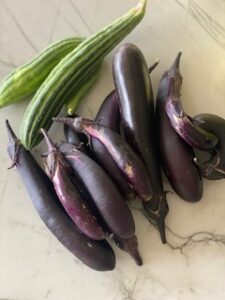
Enjoying the remnants of the summer garden
September Vegetable Garden Checklist Tips from Paula Wolfel
Vegetable gardeners and most everyone else welcome the arrival of September because it means cooler temperatures are on the way. Though the daytime temperatures are still hot, at some point in September, the nighttime temperatures begin to fall. That little drop will take heat stress off of plants and help make our gardens beautiful again. Gardeners are enjoying harvests from the plants that survived their summer gardens such as eggplant, cucumbers, melons, and tomatoes as well starting new with fall plantings.
The September Vegetable Garden Checklist
WATER
- Daily watering is important for new transplants during the first two or so weeks as they put down roots. Water the soil before putting the plant in the soil.
- Keep an eye on the sky – plants prefer rain water so if it is going to rain or rained the night before, skip your regularly scheduled irrigation until you can determine how much rain was received. Dry conditions in a vegetable garden can lead to delayed maturity, low yields, and poor quality so understanding soil moisture is crucial.
- When planting seeds also water the soil before planting, then keep the soil most until the seeds have germinated.
- Avoid watering in the middle of the day because water can be lost to evaporation. That’s mostly because the plant has closed it’s stomata to prevent water loss and doesn’t absorb water at the same rate that it does during cooler morning temperatures. The water that is applied to the soil during the hottest parts of the day is then just evaporated away.
- Most vegetables have a growth stage when water is most critical: during head development for broccoli and cauliflower; during flowering and pod enlargement for beans and peas, and during root enlargement for radishes, beets, and carrots. Lettuce and other leafy vegetables do best with a fairly consistent supply of moisture from planting to harvest.
FERTILIZE
- Sidedress vegetable transplants 3-4 weeks after planting. To sidedress, pull back mulch, sprinkle 2 tablespoons of fertilizer around the perimeter of the plant, scratch it lightly into the soil, water well, and replace mulch. Repeat this application of fertilizer again 3 weeks later to maintain healthy and vigorous growth. Keep soil moisture even so that the fertilizer doesn’t “burn” the plant.
SOIL
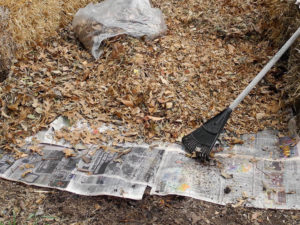
Use newspapers and mulch to protect soil and suppress weeds.
- Clean up any dead plants.
- Keep soil covered to conserve moisture, moderate temperature, and deter weeds.
- One low-cost way to protect soil that is lying fallow is to spread a few layers of newspaper over the soil, wet it down, and top it with dried leaves, grass clippings, or mulch. Place drip or soaker hose underneath the leaves, grass, or mulch. This method works well for weed suppression around the perimeter of the vegetable garden too – just leave out the irrigation.
- Put down a layer of mulch. It is an important component for the vegetable garden. It moderates soil temperatures, deters weeds, helps conserve moisture, and gradually breaks down and enriches soil. Dried grass clippings, leaves, pine straw, partially decomposed compost, and shredded bark are suitable options. When you’re ready to plant, just scoop up the mulch and put it in your compost bin.
WHAT TO PLANT IN THE SEPTEMBER VEGETABLE GARDEN
- If transplants have been grown indoors or in a greenhouse, it’s a good idea to acclimate them to outdoor conditions before planting in the garden. Start by setting them in a shady spot for a few hours, gradually exposing them to more sun each day over the course of a week.
- The best time for setting out transplants is in the evening or on a cloudy day, and if rain is in the forecast, it is very good for the plant to get rainwater right after being planted.
- Broccoli, brussel sprouts, cabbage, and cauliflower are planted as transplants in order to get a harvest before the first freeze. And root vegetables such as beets, carrots, turnips, and radishes are planted as seeds because they do not like their roots disturbed. Many of the other fall plants grow well from seeds or transplants. Seeds are less expensive and give you more control over the complete life of your plant. But transplants provide a quicker harvest.
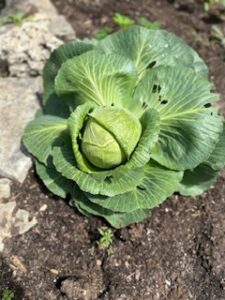 SEEDS
SEEDS
- Beets (all month)
- Carrots (all month)
- Leeks (seed all month for spring harvest)
- Radish (all month)
- Turnips (all month)
TRANSPLANTS
- Broccoli (all month)
- Brussel sprouts (all month)
- Cabbage (all month)
- Cauliflower (all month)
TRANSPLANTS OR SEEDS
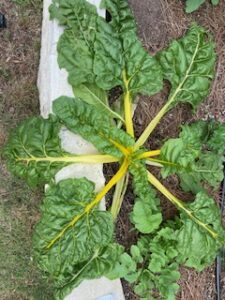
- Asian greens (all month)
- Beans, snap and lima (early to mid month)
- Chard, Swiss (all month)
- Collards (all month)
- Cucumber (early month)
- Garlic (late month)
- Greens, cold season (late month)
- Kale (all month)
- Kohrabi (late month)
- Lettuce (mid-late month)
- Mustard (all month)
- Onion, bunching/multiplying (all month)
- Peas, English, snap, and snow (all month)
- Potato, Irish (early month)
- Shallots (late month)
- Spinach (late month)
- Squash, summer (early month)
DISEASES/PESTS TO LOOK FOR IN THE SEPTEMBER VEGETABLE GARDEN
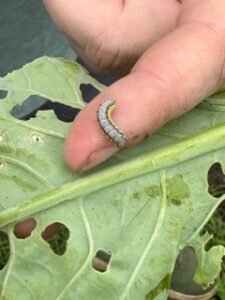
Cross-striped cabbage worm.
Fall armyworms, cabbage worms, cabbage loopers and cross-striped cabbage worms can be an issue this time of year, especially on cole crops like broccoli, kale and cauliflower. Cover new plantings with row cover to exclude the moth that lays the eggs or treat plants with a product containing Bacillus thuringiensis (Bt), which comes in either dust or spray form. Bt is deadly when consumed by caterpillars but does not harm other insects. Read the label and follow directions carefully. You can also pick them off with your fingers and either drop them in a cup of soapy water or squash them.
MAINTENANCE
- Always keep up with the weeds: they compete with young plants for water and nutrients.
- Continue to pull up any summer plants that are infested with pest damage or disease.
Additional Resources
Watch the Vegetable Gardening in Central Texas Webinar
Vegetable Planting Calendar (Español, 繁体中文)
Recommended Vegetable Varieties for Travis County
Plant Rotations, Successions and Intercropping
Sustainable Food Center Farmers Markets
Monthly Gardening Calendar for Austin and Central Texas
About Paula Wolfel
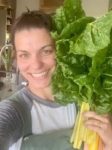 Paula Wolfel joined the Travis County Master Gardener program in 2022, but has been gardening in Austin, Texas since 2017. She grew up in the suburbs of Chicago learning how to garden from both her father—a Sicilian vegetable and fruit tree gardener—and both her grandmothers, and then spent years in Virginia gardening. Paula loves gardening because she finds it to be a grounding force- it gets her out of her head and into the present. She loves the pride that comes with cooking a meal for her family with every ingredient coming from her garden… and then the humility she feels when she loses an entire crop because of Mother Nature. She finds gardening to be wisdom, lessons, best practices passed down generation to generation, season to season and hopes to share that with you.
Paula Wolfel joined the Travis County Master Gardener program in 2022, but has been gardening in Austin, Texas since 2017. She grew up in the suburbs of Chicago learning how to garden from both her father—a Sicilian vegetable and fruit tree gardener—and both her grandmothers, and then spent years in Virginia gardening. Paula loves gardening because she finds it to be a grounding force- it gets her out of her head and into the present. She loves the pride that comes with cooking a meal for her family with every ingredient coming from her garden… and then the humility she feels when she loses an entire crop because of Mother Nature. She finds gardening to be wisdom, lessons, best practices passed down generation to generation, season to season and hopes to share that with you.

